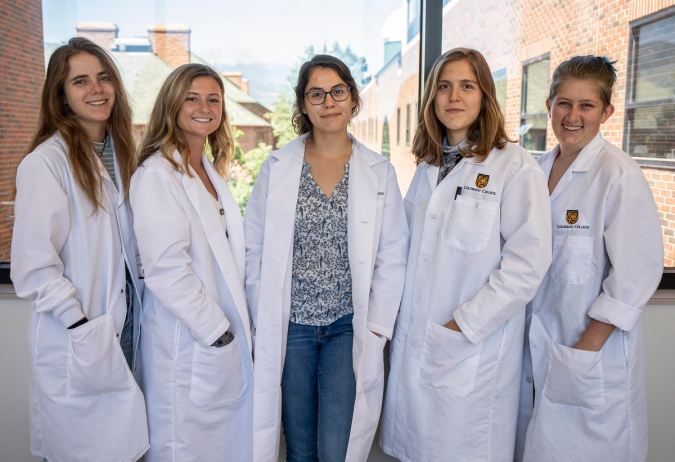
CC Assistant Professor of Molecular Biology Olivia Hatton recently published an article in the journal Frontiers in Microbiology with seven Colorado College students and a recent alumna.
The research was conducted in collaboration with the Transplant Immunology Lab at Stanford University School of Medicine.
Co-authoring the article "Epstein-Barr Virus Latent Membrane Protein 1 Regulates Host B Cell MicroRNA-155 and Its Target FOXO3a via PI3K p110α Activation," are Madeline Smith '20, Madison Alexander '20, Melanie Mandell '20, Carissa Sherman '21, Madeline Stesney '20, Joselinne Medrano '20, Kurt Ringwalt '20, and Gillian Dohrn '19.
Additionally, Sherman presented her part of the project at the Annual Biomedical Research Conference for Minority Students in Anaheim, California, in mid-November and won a presentation award. The conference is one of the largest communities of underrepresented minorities in science, technology, engineering, and mathematics. Sherman was one of more than 2,500 students from 350 colleges and universities participating in the four-day conference.
Hatton and the CC researchers note that Epstein-Barr Virus (EBV) is associated with B cell cancers such as post-transplant lymphoproliferative disorder (PTLD), a serious and often fatal complication of transplantation.
Their research asked how the main oncogene of EBV, latent membrane protein 1 (LMP1), changes expression of B cell genes to transform infected cells into tumor cells. (An oncogene is a gene that has the potential to cause cancer.) In this study, they examined how LMP1 increases expression of the B cell gene microRNA-155. Like LMP1, microRNA-155 is an oncogene. They found a new mechanism by which LMP1 increases expression of microRNA-155. Specifically, they show that LMP1 activates another B cell gene, PI3K p110a, to increase microRNA-155 expression.
MicroRNAs function by targeting genes with related sequences for destruction. Hatton and the CC researchers next examined how LMP1 regulates expression of B cell genes known to be targeted for destruction by microRNA-155. In their article, they show that LMP1 decreases expression of the microRNA-155 target FOXO3a, a tumor suppressor gene. Consistent with their earlier findings, they demonstrate that PI3K p110a is required for LMP1 to decrease FOXO3a expression. Overall, their findings suggest that PI3K p110a, microRNA-155, and FOXO3a should be examined as therapeutic targets for B cell cancers associated with EBV such as PTLD.
Sherman's part of the project focused on examining how LMP1 regulates the expression of SHIP1, another microRNA-155 target. She found that LMP1 decreases expression of SHIP1 independently of PI3K p110a.
"The main highlight for me is the work of my CC students and alumna co-author," says Hatton, an immunologist who joined the Colorado College faculty in 2015. Her interests lie at the intersection of immunology, virology, and cancer biology, with her research centering on B cell biology and how it is manipulated by EBV.


